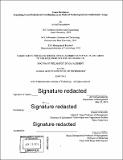| dc.contributor.advisor | Wanda Orlikowski. | en_US |
| dc.contributor.author | Karunakaran, Arvind | en_US |
| dc.contributor.other | Sloan School of Management. | en_US |
| dc.date.accessioned | 2018-09-17T15:53:27Z | |
| dc.date.available | 2018-09-17T15:53:27Z | |
| dc.date.copyright | 2018 | en_US |
| dc.date.issued | 2018 | en_US |
| dc.identifier.uri | http://hdl.handle.net/1721.1/118004 | |
| dc.description | Thesis: Ph. D., Massachusetts Institute of Technology, Sloan School of Management, 2018. | en_US |
| dc.description | Cataloged from PDF version of thesis. | en_US |
| dc.description | Includes bibliographical references. | en_US |
| dc.description.abstract | This research examines the structures, processes, and mechanisms that facilitate cross-professional coordination during periods of technological and institutional change. My study draws on a 24-month ethnographic study, combined with historical data and quantitative analysis, of 911 emergency management organizations in the United States. In Chapter 2, I focus on the mechanisms to facilitate cross-professional coordination in conditions that are marked by protracted jurisdictional conflicts. My findings articulate the importance of truce structures - an ensemble of truce roles and organizational forms - that are intended to address protracted jurisdictional conflicts among symmetrical professions such as police officers and firefighters. I further find that the coevolution of truce roles and organizational forms resulted in the emergence of a specific truce profession - in this case, that of 911 Public Safety Telecommunicators. The truce profession serves to triage, direct, and channel contested tasks among the conflicting professions without bringing those professions into direct contact with each during the initial stages of coordination when the "definition of the situation" is getting worked out. In Chapter 3, I turn to examining how the truce professionals navigate what I call status-authority asymmetry in order to effectively coordinate with the focal professionals. Conducting within-shift comparisons of coordination encounters between 911 dispatchers and police officers, I identify that the bounded publicization tactic performed via the open radio channel allows dispatchers to generate peer knowledge about individual non-compliance. Through this process, dispatchers navigate the status-authority asymmetry and orchestrate effective cross-professional coordination. My focus in Chapter 4 shifts to examining how truce professionals respond to the public's increased digital scrutiny, and consider the consequences for organizational accountability. My findings suggest that the public's increased use of mobile phones and social media to monitor and report on organizations and their workers can, under some conditions, end up worsening accountability. I unpack the processes that generate this paradox of public accountability, showing how these processes reshape the work of truce professionals and produce a vicious cycle of coordination that worsens organizational accountability. I end with a concluding chapter that discusses the implications of my dissertation for research on cross-professional coordination, accountability, and technological change. | en_US |
| dc.description.statementofresponsibility | by Arvind Karunakaran. | en_US |
| dc.format.extent | pages | en_US |
| dc.language.iso | eng | en_US |
| dc.publisher | Massachusetts Institute of Technology | en_US |
| dc.rights | MIT theses are protected by copyright. They may be viewed, downloaded, or printed from this source but further reproduction or distribution in any format is prohibited without written permission. | en_US |
| dc.rights.uri | http://dspace.mit.edu/handle/1721.1/7582 | en_US |
| dc.subject | Sloan School of Management. | en_US |
| dc.title | Truce structures : examining cross-professional coordination in the wake of technological and institutional change | en_US |
| dc.title.alternative | Examining cross-professional coordination in the wake of technological and institutional change | en_US |
| dc.type | Thesis | en_US |
| dc.description.degree | Ph. D. | en_US |
| dc.contributor.department | Sloan School of Management | |
| dc.identifier.oclc | 1051453318 | en_US |
